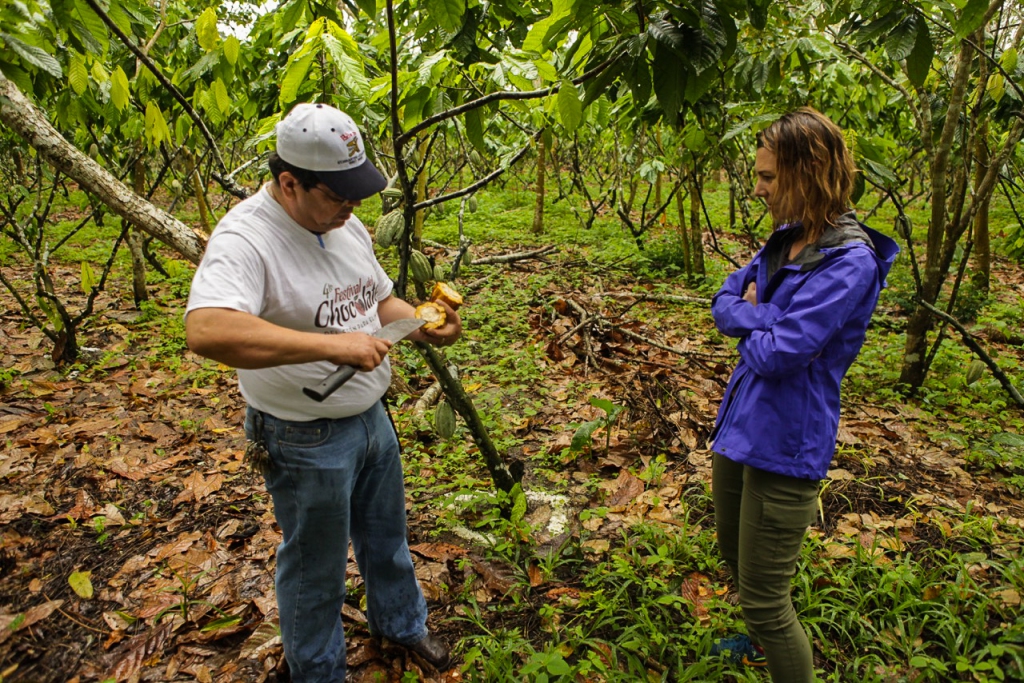“Bean to bar” is an approach to making chocolate that communicates added value and a focus on maximizing the natural flavors inherent in the cacao bean. This description recognizes the main ingredient, the transformation processes, and the end product, placing significant value on each factor which contributes to the resulting chocolate.
Although the process of making chocolate is complex, “bean to bar” is generally accepted as a short-hand term for high-quality chocolate with a focus on flavor, crafted by a maker who starts manufacturing with the actual, value-added bean.
The only ingredients necessary to craft chocolate are cacao beans and sweetener. In On Food and Cooking: the Science and Lore of the Kitchen, food science writer Harold McGee relates that, “the transformation of the fresh cacao bean into a finished chocolate is an intriguing collaboration … cacao farmers and chocolate manufacturers develop its potential … manufacturers grind the beans, add sugar, and then physically work the mixture to refine its flavor and create a silken texture.”
The cacao bean is the seed of the cacao fruit that grows on tropical trees along the equator. There are more than 600 different flavor compounds (odor-active) naturally present in cacao beans, which is important to understand the vast intrinsic flavor potential. Just like coffee and wine, chocolate can naturally taste like the fruit that it comes from.
The bean to bar process recognizes that cacao farmers and producers at origin have the ability to significantly impact the flavor and quality of their beans, the essential ingredient of chocolate. Factors including plant genetics, environment or terroir, farming and labor practices, post-harvest fermentation and drying practices, and quality standards all contribute to the flavor potential and ethics of the cacao bean.
The chocolate maker manages the next steps in the process and determines how chocolate is crafted and expressed. The maker controls chocolate expression through ingredient selection, manufacturing processes, messaging, food packaging, and delivery. There are a variety of steps involved in manufacturing, and makers choose their processes and equipment based on their desire to develop flavors and operate their businesses. There is no one-size-fits-all approach.
Craft and fine flavor chocolate makers have spent more than 25 years telling the bean to bar story (Presilla reference). While it evolves, it is agreed that the makers start with the physical bean and end with chocolate in bar form, and the flavor potential and added value in their cacao is paramount to their final expression of crafted chocolate.
To continue reading about the bean to bar chocolate-making process, visit the authors’ full post on the Goodnow Farms blog.
Próximamente versión en español






Goodnow Farms bean to bar chocolate maker Monica Rogan meets cacao grower Vicente Cacep in Tabasco, Mexico; courtesy of Goodnow Farms
Authored by
Monica & Tom Rogan, Chocolate Makers & Founders, Goodnow Farms
Chocolate Makers
References
On Food and Cooking: The Science and Lore of the Kitchen, Harold McGee (Scribner, 2004)
The New Taste of Chocolate, Maricel Presilla (Ten Speed Press, 2009)
Bean to Bar Chocolate: America’s Chocolate Revolution, Megan Giller (Storey Publishing, 2017)
Coffee Taster’s Flavor Wheel, Counter Culture Coffee (accessed January 17, 2023)
“Sweet Chocolate,“ US Food & Drug Administration (FDA), Code of Federal Relations Title 21, Section 163.123 Cacao Products (accessed December 15, 2022)
Have a comment on this definition?
